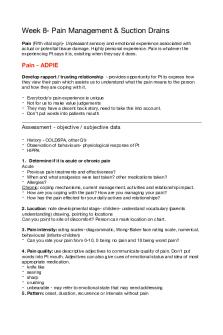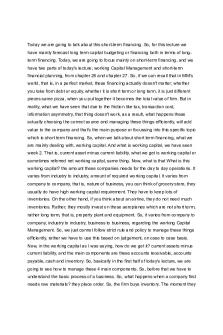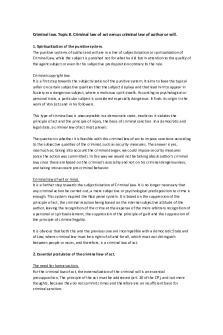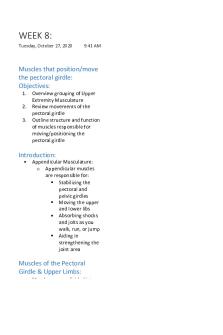Lecture Notes 8 PDF

| Title | Lecture Notes 8 |
|---|---|
| Course | Auditing |
| Institution | Brandman University |
| Pages | 2 |
| File Size | 62.4 KB |
| File Type | |
| Total Downloads | 71 |
| Total Views | 126 |
Summary
These lecture notes were written for the ACCU 460 Course taught by Professor Gerald Lege....
Description
Understand the Client’s Business and Industry •
Obtaining a good understanding of the following components allow auditors to develop a strategic approach to understand the client’s business and industry: –
Industry and external environment
–
Business operations and processes
–
Management and governance
–
Client objectives and strategies
–
Measurement and performance
Strategic Understanding of the Client’s Business and Industry
Understand client’s business and industry Industry and external environment Business operations and processes Management and governance Objectives and strategies Measurement and performance
Let’s Discuss •
Identify the eight major steps in planning audits.
•
What factors should an auditor consider prior to accepting an engagement?
•
Explain the five elements that are part of a strategic understanding of the client’s business.
•
What are the benefits derived from planning audits?
•
What is the purpose of an engagement letter? •
•
What subjects should be covered in such a letter?
Explain why auditors need an understanding of the client’s industry. •
What information sources are commonly used by auditors to learn about the client’s industry?
Perform Preliminary Analytical Procedures •
Auditing standards require the auditor to perform risk assessment procedures to: –
Obtain an understanding of the client’s business and its environment
–
Assess the risk of material misstatements in the financial statements, including inquiries of management and analytical procedures
•
Auditors are required to perform preliminary analytical procedures as part of risk assessment procedures to better understand the client’s business and industry, and to assess client business risk
•
Preliminary analytical tests can: –
Reveal unusual changes in ratios compared to prior years, or to industry averages
–
Help the auditor identify areas with increased risk of misstatements that require further attention during the audit
Let’s Discuss •
In the audit of the Worldwide Wholesale Company, you did extensive ratio and trend analysis as part of preliminary audit planning. Your analytical procedures identified the following: –
The rate of inventory turnover has steadily decreased for 3 years.
•
Evaluate the potential significance of this change on the fair presentation of financial statements.
•
State the follow-up procedures you would perform for this fluctuation to determine whether a material misstatement exists.
Materiality •
Auditing standards define materiality as: –
•
The magnitude of misstatements that individually, or when aggregated with other misstatements, could reasonably be expected to influence the economic decisions of users made on the basis of the financial statements
Auditors follow five related steps in applying materiality: –
Determines materiality for the financial statements as a whole
–
Determines performance materiality
–
Estimate the amount of misstatements in each segment
–
Estimate the combined misstatement
–
Compare combined estimate with preliminary or revised judgement about materiality...
Similar Free PDFs

8 - Lecture notes 8
- 21 Pages

8 - Lecture notes 8
- 21 Pages

8 Midwifery - Lecture notes 8
- 3 Pages

Taxation 8 - Lecture notes 8
- 2 Pages

Week 8 - Lecture notes 8
- 6 Pages

Dox 8 - Lecture notes 8
- 21 Pages

Lesson 8 - Lecture notes 8
- 2 Pages

Assignment 8 - Lecture notes 8
- 4 Pages

Week 8 - Lecture notes 8
- 23 Pages

WEEK 8 - Lecture notes 8
- 10 Pages

CL-8 - Lecture notes 8
- 12 Pages

Tema 8 - Lecture notes 8
- 8 Pages

Lesson 8 - Lecture notes 8
- 19 Pages

Chapter 8 - Lecture notes 8
- 7 Pages

Chapter 8 - Lecture notes 8
- 2 Pages

Chapter 8 - Lecture notes 8
- 7 Pages
Popular Institutions
- Tinajero National High School - Annex
- Politeknik Caltex Riau
- Yokohama City University
- SGT University
- University of Al-Qadisiyah
- Divine Word College of Vigan
- Techniek College Rotterdam
- Universidade de Santiago
- Universiti Teknologi MARA Cawangan Johor Kampus Pasir Gudang
- Poltekkes Kemenkes Yogyakarta
- Baguio City National High School
- Colegio san marcos
- preparatoria uno
- Centro de Bachillerato Tecnológico Industrial y de Servicios No. 107
- Dalian Maritime University
- Quang Trung Secondary School
- Colegio Tecnológico en Informática
- Corporación Regional de Educación Superior
- Grupo CEDVA
- Dar Al Uloom University
- Centro de Estudios Preuniversitarios de la Universidad Nacional de Ingeniería
- 上智大学
- Aakash International School, Nuna Majara
- San Felipe Neri Catholic School
- Kang Chiao International School - New Taipei City
- Misamis Occidental National High School
- Institución Educativa Escuela Normal Juan Ladrilleros
- Kolehiyo ng Pantukan
- Batanes State College
- Instituto Continental
- Sekolah Menengah Kejuruan Kesehatan Kaltara (Tarakan)
- Colegio de La Inmaculada Concepcion - Cebu